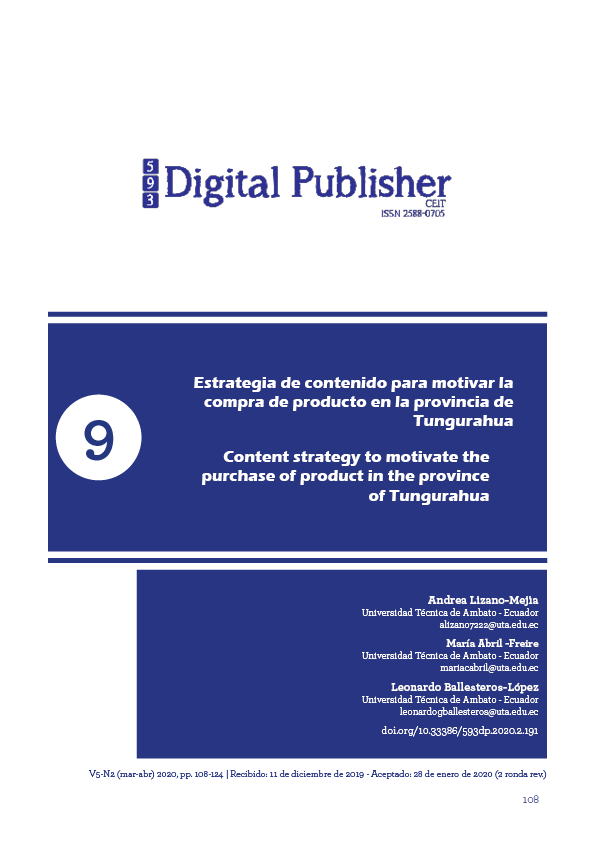Content strategy to motivate the purchase of product in the province of Tungurahua
Main Article Content
Abstract
The content strategy of Inbound Marketing is a tool that allows the identification of connection points with users, at the same time increasing potential customers and ensuring that customers are the ones looking for products. The objective of the study is to determine if the Inbound Marketing content strategy manages to develop the motivation to purchase products online in the province of Tungurahua. The research presented was not an experimental design. The study was quantified and detailed in an analytical way the criteria of the people. The scope of the research was correlational, because it was related to the factor, the purchase motivation, and the most used means in web pages. In turn, a survey was applied to 384 people that was approved by professionals, in order to make a diagnosis of the situation in the province of Tungurahua regarding the level of knowledge and use of web pages and social networks to reach the customer and attracts traffic. The main results reflect that: the internet and social networks are the new trends in the commercial sector and also a very important fact that they are safe at the time of making the online purchase. This model aims to take advantage of technology, dissemination of content, convert visits into customers, increase confidence in credibility to achieve brand positioning and market competitiveness.
Downloads
Article Details
1. Derechos de autor
Las obras que se publican en 593 Digital Publisher CEIT están sujetas a los siguientes términos:
1.1. 593 Digital Publisher CEIT, conserva los derechos patrimoniales (copyright) de las obras publicadas, favorece y permite la reutilización de las mismas bajo la licencia Licencia Creative Commons 4.0 de Reconocimiento-NoComercial-CompartirIgual 4.0, por lo cual se pueden copiar, usar, difundir, transmitir y exponer públicamente, siempre que:
1.1.a. Se cite la autoría y fuente original de su publicación (revista, editorial, URL).
1.1.b. No se usen para fines comerciales u onerosos.
1.1.c. Se mencione la existencia y especificaciones de esta licencia de uso.
References
Álvarez, F., & Ramírez, K. (2016). Propuesta estrategia de Inbound Marketing para fidelizacion de los clientes actualmente del estudio contable Ramírez, a través de redes sociales. Trunjillo: Universidad privada antenor orrego.
Arrizabalaga, N. (2019). Psicología aplicada a las ventas (COMT077PO) Manual. Madrid: Editorial cep.
Batalla, D. (2018). Marketing para las organizaciones del S. XXI. España: Formación Alcalá.
Blanco, A. (23 de Abril de 2019). Las 4 fases del Inbound Marketing. Obtenido de wanaleads: https://wanaleads.com/fases-inbound-marketing/
Caldua, M. (2019). Propuesta de aplicacion del inbound marketing para el mercado alemá de una nueva agencia de viajes virtual peruana. Perú: Usmp.
Calil, A. (2019). Inbound Marketing: Estratégias práticas para empresas e projetos (Portuguese Edition). Portugués: Casa de Código.
Castro, M., & Rodriguez, Y. (2018). Inbound marketing aplicada a los anunciantes de medios impresos del estado zulia. Marketing Visionario, 162-180.
Garau, N. (4 de Julio de 2019). ¿Cuáles son los medios de pago online más seguros? Obtenido de helpmycash: https://www.helpmycash.com/banco/medios-de-pago-online/
Garciá, V. (2011). Fundamentos de marketing : entorno, consumidor, estrategia e investigación comercial. Barcelona: Uoc.
Gil, A. (2019). Aplicacion de Inbound Marketing en el talento humano y su incidencia en las ventas de Watch Boutique - Trujillo. Perú: Unitru. Obtenido de pliccion: file:///G:/pliccion%20del%20inbound%20marketing/giltapullima_astrid.pdf
Gomes, D. (10 de Agosto de 2016). Passo a passo para começar uma estratégia de Marketing de Conteúdo. Obtenido de administradores: https://administradores.com.br/artigos/passo-a-passo-para-comecar-uma-estrategia-de-marketing-de-conteudo
Halligan, B., & Shah, D. (2009). Inbound Marketing.: Get Found Using Google, Social Media, and Blogs. New Jersey: Wiley.
Kindle, V. (2016). Digitalízate: Cómo digitalizar tu empresa. España: Libros de cabecera.
Lind, D., Marchal, W., & Mason, R. (2004). Estadistica, administracion y economía (11va Edición ed.). Colombia: Alfaomega.
Lizama, P., & Boccardo, G. (2014). Guia de asociacion entre variables Pearson y Sperarman en SPSS. En Ayudantía estadistica I (págs. 652-655). Chile: Universidad de Chile.
Lovinger, R. (27 de Marzo de 2007). Estrategia de contenido: La filosofía de los datos. Obtenido de boxesandarrows: http://boxesandarrows.com/content-strategy-the-philosophy-of-data/
Maibach, B. (2018). Analisis de la metodologia del Inbound Marketing y su efecto el proceso de compra de los buyers de backpacker hostels de miraflores. Peru: Universisdad de Lima.
Martínez , R., Tuya, L., & Otros. (2009|). El coeficiente de correlación de los rangos de Spearman caracterización. Revista Habanera de Ciencias Médicas, 19.
Monferrer, S. (10 de Septiembre de 2016). Motivacion de compra: un estudio comparativo entre pequeños comercio y los grandes centros comerciales . Obtenido de tesisenred: https://www.tesisenred.net/bitstream/handle/10803/396345/TD_2016_TenaMonferrer.pdf?sequence=1&isAllowed=y
Otero, C. (18 de Mayo de 2017). Metodología inbound: atraer, convertir, cerrar y deleitar. Obtenido de bannisterglobal: https://blog.bannisterglobal.com/metodologia-inbound-atraer-convertir-cerrar-y-deleitar
Ramos, R. (25 de Octubre de 2017). Cómo argumentar las motivaciones de compra de tu cliente. Obtenido de ventasexito: https://www.ventasexito.com/como-argumentar-las-motivaciones/
Ruiz , E. (26 de Julio de 2016). La pirámide de necesidades de Maslow aplicada al Marketing Digital. Obtenido de Aulacm: https://aulacm.com/piramide-necesidades-de-maslow-marketing/
Ruiz, L. (2 de Febrero de 2017). Cómo diseñar una estrategia de marketing de contenidos. Obtenido de aukera: https://aukera.es/blog/estrategia-contenidos/
Sampieri, H. (2014). Metodilogía de la investigación. México: McGrawHill

